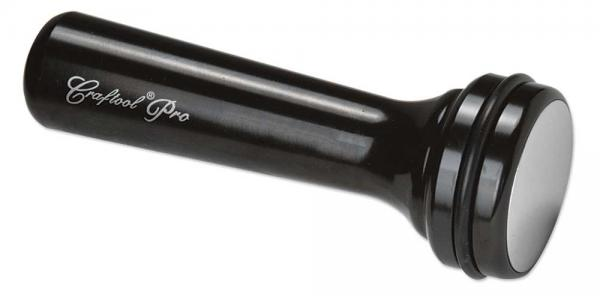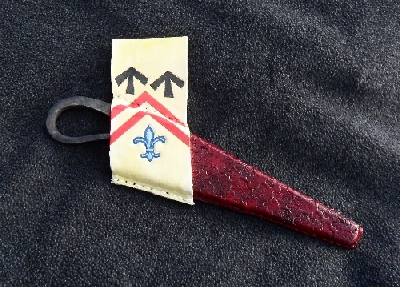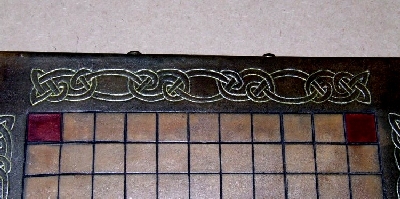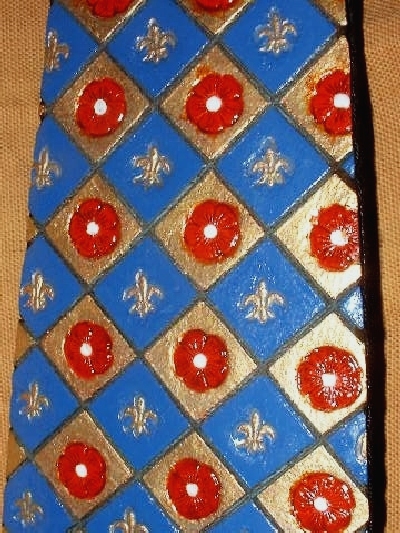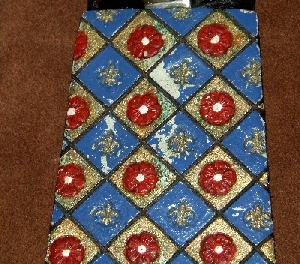-
Posts
5,926 -
Joined
Content Type
Profiles
Forums
Events
Blogs
Gallery
Everything posted by fredk
-
Don't with the car wax; it usually contains additives like silicon which are not good for leather. Beeswax, carnuba, neetsfoot oil mix feeds the leather and gets right into it. Car wax doesn't and remains on the surface >>> Plastic bags are too expensive here [yes, really, about $1 each for a small bag for a few groceries and they fall apart as soon as you use them] I use the free newspapers that come thru my letter box Same as Matt; cheap sponges from supermarket shop
-
Other than doing an applique panel why not offer to create a new holster, and you can practice your tooling?
-
I'd reckon it would very difficult to add tooling to the holster now. I think the best option is to do the work on a separate panel and attaching it by sewing it on
-
I've mixed opinion on making belts out of belly; for a man - no, for a woman - usually yes As said above; if used to wet mould anything it usually toughens up a bit. Dipping it in very warm water and warm drying quickly toughens it up as well. Bellies make decent clutch bags which owners seem to fill till they stretch. Coin bags/purses too.
-

Home made Stainless Steel Burnisher First Stage.
fredk replied to ContactCement's topic in Leather Tools
Will a stacked leather grip be enough around a bolt that size diameter? Perhaps a wood handle might be better Chaps, He's making a burnisher that looks a bit like this; https://www.tandyleather.eu/en/product/craftool-pro-leather-burnisher -
I don't own any Osborne but I think their tools are better than most Craftool
-
I don't use 'conchos' per se but I have used ornaments on belts and bags which have required either a ready-rivet or screw to hold them on. If the base leather is thick enough I try to skive a depression for the head - rather like counter-sinking a screw into wood. Even if I can or can't do that I glue a very thin piece of pig or deer skin leather over the head. On a couple of occasions I have taken a rough metal file to a screw head to reduce it greatly. The thicker the lining material the less noticeable the bump of the screw head will be. I have used 0.9 to 1.1mm thick upholstery leather as lining for bags and the bump isn't noticeable, you have to rub a finger over the area to find the attachment screw head
-

Latest Project
fredk replied to Sheilajeanne's topic in Purses, Wallets, Belts and Miscellaneous Pocket Items
I would say ; forget two tone dyeing and masking et al and use acrylic paint for details Here's a knife sheath I did some several years ago. The device on the hangar was coloured in with acrylic paint. afaik they are still showing well all this time later. Another; I made this one nearly 20 years ago. I tooled it, primed it with white acrylic paint and used acrylic paints for the details I got it back a couple of years ago for repainting. This is it after about 15 or 16 years of use, worn in all sorts of weather on about 15 days a month for 10 months of each year, thrown into a trunk with maille armour and tools and other weapons. The paint never got anything more than two coats of Pledge Klear floor 'polish' which is actually an acrylic varnish Gel ink pens are also good for outlining. They can be used for colouring in as well but aren't great for that duty. I used one to outline the lace work on this game board The acrylic paints I used are made by Humbrol, meant for builders of plastic models. I now use paints by Vallejo and Revell as well I think, before you part with that bag, if you think it needs it, paint over the horses with acrylic paint, then use a red gel ink pen on the fine lines within the pattern. Let it all dry for at least a few days then gently put on a sealant. Do not go wet with the sealant or go heavy with sponge or brush as that will smudge the gel ink - it never dries totally waterproof. Ideally spray the sealant. If you don't have an airbrush you can put on a light coat or two of a car paintwork clear lacquer or a car clear plastic primer both of which comes in spray cans. [The lacquer is handy to have in the work room] The lacquer will water seal the gel ink, then you can put on more coats of resolene to both seal it and give it extra lustre. If you're not sure about doing this try it out on a practice piece first -

Latest Project
fredk replied to Sheilajeanne's topic in Purses, Wallets, Belts and Miscellaneous Pocket Items
That looks quite grand so it does -
I put very small patterns in A5 document wallets, larger than that size they go into A4 document wallets and the lot are dumped into a 42 liter [underbed] plastic storage box*. Any pattern which I can't fit into the A4 wallet goes straight into the big box. All patterns are written on what they are and construction notes. If they are lucky the wallets get written on too. Its kinda no wonder I can't, or rarely can, find an old pattern and I end up cutting a new one! Now that I'm remodeling my workspace I just might sort out all those old patterns. I see a lot of old card heading to the recycling box in my future *I use shelf units in my work space and two 42L boxes fit on each shelf
-
Regular Fiebing alcohol based dye
-

Foo FIghters Buckel less belt
fredk replied to plinkercases's topic in Purses, Wallets, Belts and Miscellaneous Pocket Items
Looks grand so it does. Once it gets some wearing the letters will look just dandy -
Go to 480volt's signature; on the far right, at the top is a little x. Click on that and it will give you an option to ignore his signature. It makes the picture go away Yes. I use the 1.75 size for all my belts and straps except for the very littlest ones eg 16mm and below. It just needs careful alignment to get the V even on both sides
-
I get a picture of a roll of steel cable. The picture is approx 4 to 5 times the size of your actual message block in the above post. I use a lap top with a 15 inch screen. The height of the screen is 7.5 inches and the picture is larger than this [using my Firefox browser at 100%]
-
Check out LePrevo in England Slot Punch T129 http://www.leprevo.co.uk/hole-punches.htm http://www.leprevo.co.uk/photos/slot-punch.html I use them and they are good They also do the belt end punches T130 http://www.leprevo.co.uk/knives.htm
-
No websites; I get them thru ebay
-
The problem with that is you are never free of home-work, .................all your school work is home work! Does that make me a Neolithic 59er?
-
A. I mould with the flesh side to the mould only ie the inside of a case. I've never had leather stick to the mould itself, just sometimes to the support board; which never gets polished up B. As its the inside of a case which is against the mould I've never checked if the polish transferred to the leather; never occurred to me to check. Its certainly never been noticeable C. Its not a lot of spray polish I use; a light spray, then a wipe over with a soft cloth D. No point telling you any make as I'm in a different country with different makes, and its whichever one is in my cupboard at the time I need it
-
Now that you mention the subject; I might use a release agent without meaning to. I sand and varnish, sand and varnish my moulds till they are really smooth. The last thing I do is I spray on some ordinary household furniture polish and buff that smooth. That polish might be acting as a release agent
-
A suggestion; and I'm not being facetious or silly with this. Get your colour perception tested. 95% of men have some degree of colour blindness whereas only 10% of women have some colour blindness [figures are approximate] I am colour blind. On a scale of 1 [perfect colour perception] to 10 [black & white only] I come in at about 8 Most browns and dark browns, dark greens and very dark blues look the same to me
-
Thinning the dye can help get lighter tones, building up to darker by more coats. It won't give you more time tho
-
Not that long ole chap. Only about 18 years I found that normally dry leather absorbs the dye unevenly. By dampening the leather, not too wet, the water helps the dye spread thru the leather giving it a more even absorption, I make sure my sponge is not dripping wet with the dye as well as if it is the first part you touch will get the most dye and the rest of the leather will get a minimal amount. A sponge wetted with dye then squeezed out applies dye more evenly I use Fieblings dye which I dilute with methylated spirits [alcohol]
-
For large areas I dampen the leather and apply dye with a sponge about 3 x 4 inches. I apply in a few straight strokes then go over it using circular For medium sized item I dip dye. I use a stainless steel oven baking tray. I dilute the dye about 2 alcohol to 1 dye
-
Definitely throw it away As you, and I, are in three different places its not a water-borne mould. It might just be an air-borne non-toxic mould. The glue pot has given it a nice home to grow in. You can limit this by adding a small amount of bleach and keeping the glue in a dark container, or in a dark place which is also cold, but not freezing. Warm & bright encourages the mould to grow



